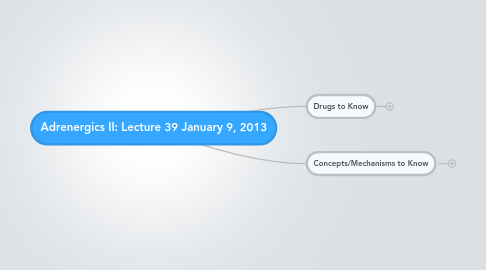
1. Drugs to Know
1.1. Beta Blockers
1.1.1. Propanolol
1.1.1.1. MOA: competitive antagonist at beta adrenergic receptors
1.1.1.1.1. Clinical Use: HTN, angina, cardiac arrhy. ischemic heart disease, many others (no effect on BP in normotensive ppl)
1.1.1.1.2. Special Info: 1st line for angina, it slows the AV node conduction in arrh. standard of care post-MI, NOT first line for HTN.
1.1.2. Metoprolol
1.1.2.1. MOA: competitive antagonist at beta1 adrenergic receptors (specifically beta1 blockade)
1.1.2.1.1. Clinical Use: HTN, angina, cardiac arrhy., ischemic heart disease, congestive heart failure (CHF)
1.1.2.1.2. Special Info: Metoprolol blocks beta 1 which is almost exclusively expressed in the heart; therefore, it has cardioselectivity!
1.1.3. Atenolol
1.1.3.1. MOA: competitive antagonist at beta1 adrenergic receptors (specifically beta1 blockade)
1.1.3.1.1. Clinical Use: HTN, angina, cardiac arrhy., ischemic heart disease, congestive heart failure (CHF)
1.1.3.1.2. Special Info: Like metoprolol, Atenolol blocks beta 1 which is almost exclusively expressed in the heart; therefore, it has cardioselectivity!
1.1.4. Esmolol
1.1.4.1. MOA: ultra-short acting beta blocker (10mins)
1.1.4.1.1. Clinical Use: IV given to limit catecholamine-mediated cardiac stimulation, especially in surgery (inhibits tachycardia)
1.1.4.1.2. Special Info: This drug has an very short half-life. It clears very fast!- This is because it gets hydrolized by enzymes in the blood.
1.1.5. Timolol
1.1.5.1. MOA: Non-selective beta blocker. Decreases aqueous humor production in eye thus reducing interocular pressure.
1.1.5.1.1. Clinical Use: Glaucoma (topical); hypertension and angina (systemic)
1.1.5.1.2. Special Info: enters CNS, longer half-life than propanolol and fewer side effects.
1.1.5.2. Issues:
1.1.5.2.1. Can have adverse effects on the heart and airways in patients with Asthma, pacemakers, and conduction pathway disease!
1.2. Intrinsic Sympathomimetic Activity
1.2.1. Pindolol
1.2.1.1. MOA: partial agonist at all beta adrenergic receptors
1.2.1.1.1. Clinical Use: Tx Hypertension
1.2.1.1.2. Special Info: This drug is good for ppl with bradycardia but high BP.
1.2.1.2. Advantages
1.2.1.2.1. Less cardiac depression (sub-max effect at beta 1 receptors
1.2.1.2.2. sill block exercise-induced increases in heart rate
1.2.1.2.3. Less tendency to cause bronchoconstriction (sub-max effect at beta 2)
1.2.1.2.4. Significantly reduces peripheral resistance (sub-max vasodilation at beta 2)
1.3. Mixed alpha/beta blockers
1.3.1. Labetalol
1.3.1.1. MOA: Racemic mixture with one isomer and alpha1 antagonist and another a nonselective beta antagonist (some partial b2 partial agonist activity)
1.3.1.1.1. Clinical Use: HTN, especially during hypertensive emergencies
1.3.1.1.2. Special Info: The drug is used during emergencies
1.3.2. Carvedilol
1.3.2.1. MOA: mixed alpha 1 nonselective beta antagonist
1.3.2.1.1. Clinical Use: HTN without reflex tachycardia (beta 1 blockade)
1.3.2.1.2. Special Info: Increases effects of calcium entry blockers, clonidine, digoxin, insulin, antidiabetics.
1.3.2.2. Contraindicated patients
1.3.2.2.1. Asthma patients
1.3.2.2.2. Bradycardia patients
1.4. Prazosin
2. Concepts/Mechanisms to Know
2.1. Sympathomimetic effects on BP/HR
2.2. Baroreceptor Reflex
2.3. Epinephrine Reversal
2.4. Beta Blocker withdrawal syndrome
2.4.1. beta blocker withdrawal syndrome.png
